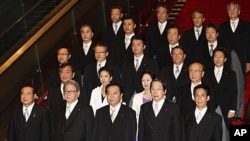Japan’s new prime minister and his cabinet were installed Friday at an Imperial Palace ceremony, officially marking the start of the latest government.
In a wide-ranging news conference, just prior to Prime Minister Yoshihiko Noda convening his first Cabinet meeting, much of the focus was on the ongoing recovery effort from the March 11 earthquake and tsunami.
Noda says it is imperative to speed efforts to rebound from the disaster. He mentions concerns about radiation from the meltdown of reactors at the Fukushima-1 nuclear plant, triggered by the natural disaster. The prime minister says Japan cannot be whole again without revitalizing the Fukushima region where numerous villages and towns were evacuated because of the radiation levels.
Noda says time is running out to improve the country’s economy if it wants to avoid risk to its debt rating. He has called for “bold economic and fiscal steps” and is on record as favoring tax hikes.
Noda added that the alliance with the United States will be at the core of his administration’s foreign policy, but he said he also wants to expand relations with Asian countries.
In response to a reporter’s question, Noda said he would not visit, during his tenure, the controversial Yasukuni war shrine, regarded by Japan’s neighbors as a symbol of the country’s imperialist aggression before and during World War Two.
It took the new prime minister several days to form his cabinet. Most Japanese prime ministers announce their administration lineup within a day of winning parliamentary approval, which Noda accomplished on Tuesday. The delay is seen as an indication of infighting among influential Democratic Party of Japan politicians.
Noda chose a close ally, Osamu Fujimura, for the critical post of Chief Cabinet Secretary, who also acts as the top government spokesman.
Fujimura, a veteran politician is best known for his resemblance to a famous Japanese cartoon cat, named Doraemon.
Most of the other Cabinet faces are less familiar to the public, but several are notable for their relative youth.
The new prime minister is Japan’s third youngest ever, at age 54.
Taking over the finance ministry post from Mr. Noda is 49-year-old Jun Azumi. He worked as a political journalist at public broadcaster NHK before becoming an independent politician. His hometown, Ishinomaki, a small coastal city suffered extensive damage in the March 11 earthquake and tsunami.
About 4,000 of its residents perished.
The new foreign minister is 47-year-old Koichiro Genba, also a DPJ politician, who was in charge of national strategy under the prior administration of Prime Minister Naoto Kan. Genba is known as an advocate of free trade.
Forty-year-old Goshi Hosono is being retained as the special minister handling the ongoing crisis caused by the Fukushima reactor meltdowns. Hosono will also serve as environment minister.
A former agriculture ministry bureaucrat turned politician, Yasuo Ichikawa, is Japan’s new defense minister.
There is little initial enthusiasm among the Japanese public for the new cabinet. Analysts say constituents have grown weary after seeing the previous five administrations end within 15 months.
New Japan Cabinet Convenes; Serious Challenges Ahead








